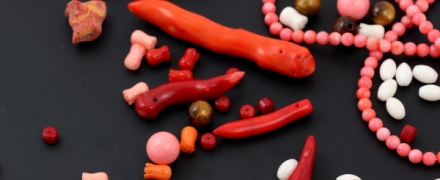open 10 am - 7 pm
laboratory is closed
Corals on the neck

In products marketed as coral, it is important to distinguish between “precious”, “gem” or “precious” corals from “common”, “non-gem” or “common” corals. Often in the jewelry market you can find many different imitations of coral - from artificial (carved from any materials, cast from glass, printed from plastic on a printer) to natural (rocks and processed minerals, shells, lime algae, etc.). Dyed and impregnated non-noble corals or marine calcareous algae are most common among inserts in products. Moreover, even experienced dealers often openly confuse dyed ignoble "bamboo" coral (colonial coelenterates) and calcareous algae (plants) from the order Corallinales (namely, their geniculate forms). In well-selected and processed inserts, the answer to the question of what kind of material it is can only be given by genetic analysis or by examination of transparent thin sections under a microscope. Often, this analysis for a single item is much more expensive than the item itself. Regardless of whether it is algae or "ignoble" coral - their cost and consumer properties in the product are the same. There is only one of the peculiarities of some algae beads - the remnants of plant material when staining the "skeleton" of the alga, which turns black and forms characteristic spots. Having seen the price of the product, you can already guess what kind of material you are dealing with - "noble" coral costs several times more, while the seller provides guarantees and accompanying documents confirming the type of material, the presence or absence of refinement.
В геммологической практике бывают весьма увлекательные случаи с диагностикой ювелирных вставок
Но помимо редкости цвета и высокой стоимости таких камней, многие розовые камни выделяются одной замечательной особенностью – они проявляют плеохроизм, то есть в зависимости от положения осмотра камня он может иметь дополнительные оттенки – оранжевый или пурпурный.
Currently, gemstones are produced by two fundamentally different technological methods - the High Pressure - High Temperature method (“HPHT”, High-pressure & High-temperature) and the Chemical Vapor Deposition (“CVD”, Chemical vapor deposition) method. The "HPHT" method is the most tested classical synthesis method, which can be used both carbon deposition on diamond from flux melts and catalytic reactions. In "CVD" synthesis, diamond growth occurs on a seed during carbon deposition mainly from a gaseous medium at relatively low temperatures and pressures.
Jewelry and precious stones are just such a category of goods, when buying which you need to pay attention to many criteria.
Sogdianite is a rather rare mineral and more often it can be found as a collection material (moreover, in systematic collections), and it is extremely rare in jewelry.






